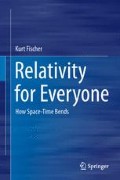Abstract
In the first two chapters, we reexamined such basic concepts as space and time from the very start, things that the philosopher Kant thought to be built into our brain to be able to grasp the world around us. Then how did Einstein get the idea for his theory of special relativity? There was a road map at hand, a blueprint of what was to be expected: That was, and still is, the theory of moving electrical charges, that is, electrodynamics. The reason is simple: While mass, time, and length change with speed relative to the observer, electrical charge is absolute, like the speed of light. We will demonstrate this at a simple example, a straight wire carrying an electric current. We will see why the magnetic field around this wire shows relativity in everyday life. This example was the starting point for the theory of special relativity.
Access this chapter
Tax calculation will be finalised at checkout
Purchases are for personal use only
Notes
- 1.
A. Einstein. Das Prinzip von der Erhaltung der Schwerpunktsbewegung und die Trägheit der Energie. Annalen der Physik, volume 20, page 627, 1906.
- 2.
Some textbooks specify the electrical current to flow in opposite direction to the flow of the electrons. Then the left-hand rule becomes a right-hand rule, but of course the physical phenomena do not change.
Some other textbooks use the Fleming left hand rule. However, this rule uses the fingers in a different order, and would become a right hand rule in our case: The electrons move in the direction of the right middle finger, and the magnetic field points in the direction of the right forefinger, so that the force on the moving electrons points in the direction of the thumb, that is, again upwards.
- 3.
Many textbooks use a rotating magnet for this thought experiment.
Author information
Authors and Affiliations
Rights and permissions
Copyright information
© 2013 Springer International Publishing Switzerland
About this chapter
Cite this chapter
Fischer, K. (2013). Light, Electricity, and Magnetism. In: Relativity for Everyone. Springer, Heidelberg. https://doi.org/10.1007/978-3-319-00587-4_3
Download citation
DOI: https://doi.org/10.1007/978-3-319-00587-4_3
Publisher Name: Springer, Heidelberg
Print ISBN: 978-3-319-00586-7
Online ISBN: 978-3-319-00587-4
eBook Packages: Physics and AstronomyPhysics and Astronomy (R0)

